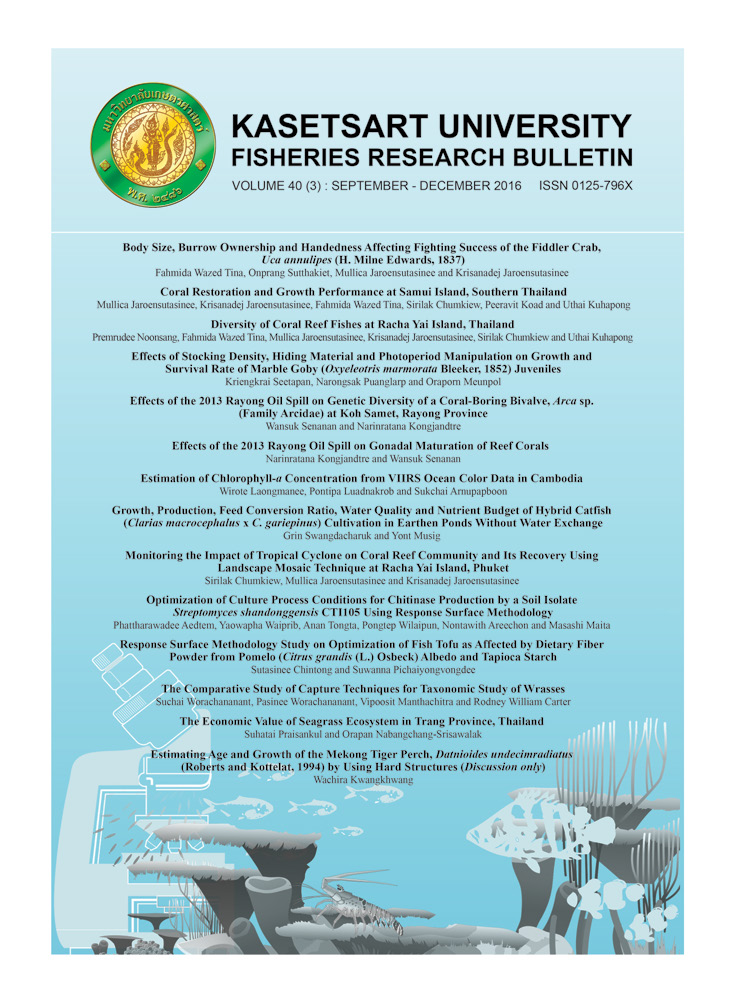Effects of the 2013 Rayong Oil Spill on Genetic Diversity of a Coral-Boring Bivalve, Arca sp. (Family Arcidae) at Koh Samet, Rayong Province
Main Article Content
Abstract
One of the public concerns over the 2013 oil spill incident in Rayong, Thailand was the effect of oil and dispersed oil on marine organisms. This study examined short-term effects of the oil spill on abundance and genetic variation of a coral-boring bivalve, Arca sp. (Family Arcidae) at Koh Samet, in areas with direct (Ao Phrao), moderate (Ao Luk Yon) and minimal (Ao Lung Dam) exposure to oil. One month after the oil spill, the average abundance of Arca sp. was highest at Ao Phrao (5.07 ± 9.21 individuals/m2) although the abundance did not statistically differ among sites. Genetic variation within each sample, inferred from three microsatellite loci, did not differ among locations (allelic richness = 6.88±1.93 (LY1) to 8.85±1.64 (LD1), and observed heterozygosities = 0.36±0.15 (LY1) to 0.53±0.05 (LD1)) at both sampling periods, one and six months after the oil spill. Ao Phrao and Ao Luk Yon samples were not genetically different but we detected a difference between Ao Lung Dam sample and the remaining samples. Our results suggest limited short-term impacts of the oil spill on genetic diversity of this clam species. To evaluate long-term effects, we may need to monitor morphological changes, possibly due to genetic selection, among generations in these populations.
Article Details
References
2. Allendorf, F.W., G. Luikart. 2007. Conservation and the genetics of populations. Blackwell publishing, Malden, MA. 643 pp.
3. Bue, B.G., S. Sharr, J.E. Seeb. 1998. Evidence of damage to pink salmon populations Inhabiting Prince William Sound, Alaska, two generations after the Exxon Valdez Oil Spill. Transactions of the American Fisheries Society. 127: 35-43.
4. Chen, S.Y., H.J. Ji, S.X. Xu, Z.W. Zhang, X.F. Xu. 2009. Polymorphic microsatellite DNA markers for the ark shell Scapharca subcrenata (bivalve: Arcidae). Conservation Genetics. 10:1409-1412
5. Dieringer, D., C. Schlötterer.2003. Microsatellite analyser (MSA): a platform independent analysis tool for large microsatellite data sets. Molecular Ecology Notes. 3:167-169.
6. Elmgren, R., S. Hansson, U. Larsson, B. Sundelin, P. D. Boehm. 1983. The "Tsesis" oil spill: Acute and longterm impact on the benthos. Marine Biology. 73:51-65.
7. Etienne Bezault, X. Rognon, K. Gharbi, J. Francois Baroiller, B. Chevassus. 2012. Microsatellites Cross-Species Amplification across Some African Cichlids. International Journal of Evolutionary Biology. Article ID 870935, 7 pages. doi:l0.1155/2012/870935
8. Excoffier, L., 2007. Analysis of population subdivision, pp. 980-1020 in D.J. Balding, M. Bishop and C. Cannings. (eds) Handbook of Statistical Genetics 3rd edition, volume 2. John Wiley & sons, Ltd., West Sussex, UK.
9. Feng, Y-W., Q. Li, L.-F. Kong. 2009. Isolation and characterization of 14 polymorphic microsatellite loci in the ark shell Scapharca subcrenata (Bivalvia: Arcidae). Conservation Genetics. 10:1125-1127.
10. Fernádez-Tajes, J., A. Arias-Pérez, M. Fernandez-Moreno. 2012. Sharp decrease of genetic variation in two Spanish localities of razor clam Ensis siliqua: natural fluctuation or Prestige oil spill effects? Ecotoxicology.21 (1):225-233.
11. Foulley, J-L L. Ollivier. 2006. Estimating allelic richness and its diversity. Livestock Science.101:150-158.
12. Guo, S.W., E.A. Thompson. 1992. Performing the exact test of Hardy-Weinberg proportion for multiple alleles. Biometrics.48:361-372.
13. Khowhit, S., K. Chunkao, W. Inkapatanakul, O. Phewnil, A. Boutson. 2015. Reproductive Cycle of Meretrix meretrix in the Coastal Area of Laem Phak Bia, The King's Royally Initiated Laem Phak Bia Environmental Research and Development Project, Phetchaburi Province. Thai Science and Technology Journal. 23:59-72.
14. Kongjandtre, N., W. Senanan. 2014. Ecological impacts of crude oil spill on coral ecosystem, coral reproduction and genetic variation of a bivalve population. Final report submitted to PTT Global Chemical Public Company Limited. pp. 69.
15. Peakall, R, P.E. Smouse. 2006. GENALEX 6: genetic analysis in Excel. Population genetic software for teaching and research. Molecular Ecology Notes. 6:288-295.
16. Piñeira, J., H. Quesada, E. Rolán-Alvarez, A. Caballero. 2008. Genetic impact of the Prestige oil spill in wild populations of a poor dispersal marine snail from intertidal rocky shores. Marine Pollution Bulletin. 56:270- 281.
17. Rice W.R 1989.Analyzing table of statistical tests. Evolution. 43:223-225.
18. Rousset, F. 2008. Genepop'007: a complete reimplementation of the Genepop software for Windows and Linux. Molecular Ecology Resources. 8: 103-106.
19. Street, G.T., G.R. Lotufo, F.A. Montagna, Fleeger. 1998. Reduced genetic diversity in a meisobenthic copepod exposed to axenobiotics. Journal of Experimental Marine Biology and Ecology. 222: 93-111.
20. Srisampan, C. 2000. Spawning cycle of the bloody cockle, Anadara granosa (L.) at Muangmai, Chonburi Province, Thailand Master's Thesis, Burapha University.
21. Suchanek, T.H. 1993. Oil impacts on marine invertebrate populations and communities. American Zoologist. 33: 510-523.
22. Varela, M.A., A. Martínez-Lage, A.M. González-Tizón. 2012. Genetic heterogeneity in natural beds of the razor clam Ensis siliqua revealed by microsatellites. Journal of the Marine Biological Association of the United Kingdom. 92:171-177. doi:l0.1017/ S0025315411000646.
23. Ye, Y.Y., C.W. Wu, J.J. Li. 2015. Genetic Population Structure of Macridiscus multifarius (Mollusca: Bivalvia) on the Basis of Mitochondrial Markers: Strong Population Structure in a Species with a Short Planktonic Larval Stage. PLoS ONE. 10(12): e0146260. doi:10.1371/journal.pone.0146260.


